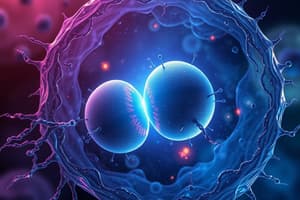Podcast
Questions and Answers
Age is a significant factor contributing to the development of neoplasia.
Age is a significant factor contributing to the development of neoplasia.
True (A)
Hormones do not influence the development of any cancers.
Hormones do not influence the development of any cancers.
False (B)
Diet contains no carcinogenic agents that can contribute to cancer risk.
Diet contains no carcinogenic agents that can contribute to cancer risk.
False (B)
Personal habits like smoking and alcohol consumption decrease the risk of cancers.
Personal habits like smoking and alcohol consumption decrease the risk of cancers.
Certain racial groups may have increased susceptibility to specific cancers.
Certain racial groups may have increased susceptibility to specific cancers.
Local spread of malignant tumors involves detachment and migration of tumor cells.
Local spread of malignant tumors involves detachment and migration of tumor cells.
Malignant tumors only spread through direct contact with surrounding tissues.
Malignant tumors only spread through direct contact with surrounding tissues.
Distant spread of malignant tumors is most commonly achieved through blood vessels.
Distant spread of malignant tumors is most commonly achieved through blood vessels.
A larger embolus is more likely to become established as a new tumor than a smaller embolus.
A larger embolus is more likely to become established as a new tumor than a smaller embolus.
Inflammatory responses at the site of impaction can promote tumor cell growth.
Inflammatory responses at the site of impaction can promote tumor cell growth.
Certain organs are more favorable for tumor growth due to their structure.
Certain organs are more favorable for tumor growth due to their structure.
All types of cancer have the same metastatic tendencies.
All types of cancer have the same metastatic tendencies.
Changes at the site of impaction can enhance the likelihood of tumor cell establishment.
Changes at the site of impaction can enhance the likelihood of tumor cell establishment.
The presence of blood vessels is more characteristic of metastasis in sarcomas than in carcinomas.
The presence of blood vessels is more characteristic of metastasis in sarcomas than in carcinomas.
Smaller tumors are always more successful in metastasizing than larger tumors.
Smaller tumors are always more successful in metastasizing than larger tumors.
Metastasis in sarcomas occurs later than in carcinomas.
Metastasis in sarcomas occurs later than in carcinomas.
Metaplasia refers to the adaptive substitution of one type of adult cell for another within the same category.
Metaplasia refers to the adaptive substitution of one type of adult cell for another within the same category.
Hyperplasia results in a decrease in cell number within a tissue or organ.
Hyperplasia results in a decrease in cell number within a tissue or organ.
Agenesis is the term used to describe the complete absence of an organ or tissue.
Agenesis is the term used to describe the complete absence of an organ or tissue.
Anaplasia denotes the abnormal organization or development of cells and tissues.
Anaplasia denotes the abnormal organization or development of cells and tissues.
Atrophy leads to an increase in the size and weight of a tissue or organ.
Atrophy leads to an increase in the size and weight of a tissue or organ.
Dysplasia is often associated with abnormal organization of epithelial cells and tissues.
Dysplasia is often associated with abnormal organization of epithelial cells and tissues.
Neoplasia is characterized by controlled proliferation of cells.
Neoplasia is characterized by controlled proliferation of cells.
Carcinogenesis is the process of tumor formation from normal cells.
Carcinogenesis is the process of tumor formation from normal cells.
Study Notes
Disturbances of Growth
- Disturbances in cell growth can lead to various pathological conditions, ranging from complete absence of tissue development to uncontrolled growth.
Non-Cancerous Disturbances
- Developmental Disturbances:
- Agenesis: Complete absence of an organ or tissue.
- Aplasia: Failure of an organ or tissue to develop.
- Hypoplasia: Underdevelopment or incomplete development.
- Atresia: Failure of a hollow organ to canalize.
- Acquired Adaptive Disturbances:
- Atrophy: Decrease in size and weight due to reduced cell size or number.
- Hypertrophy: Increase in size due to enlarged cells.
- Hyperplasia: Increased cell number.
- Metaplasia: Adaptive substitution of one cell type for another within the same category.
- Acquired Non-adaptive Disturbances:
- Dysplasia: Abnormal organisation or development of cells and tissues.
- Anaplasia: De-differentiation of cells to a more embryonic state.
Cancerous Disturbances (Neoplasia)
-
Characterised by:
- Uncontrolled proliferation.
- Resemblance to cells of origin.
- Lack of orderly arrangement.
- No useful function.
- Unclear cause.
-
Neoplasia is irreversible and mechanisms controlling normal cell growth are permanently impaired in neoplastic cells.
Carcinogenesis (Oncogenesis)
- The transformation of a normal cell into a neoplastic cell.
- Causes include:
- Unknown factors.
- Environmental Agents:
- Chemical carcinogens.
- Radiation.
- Infectious agents:
- Viral (Oncogenic viruses)
- Bacterial (Helicobacter pylori)
- Parasitic (Bilharziasis)
- Chronic inflammation.
Studying That Suits You
Use AI to generate personalized quizzes and flashcards to suit your learning preferences.
Related Documents
Description
Explore the various disturbances of cell growth that can lead to pathological conditions. This quiz covers both non-cancerous and cancerous disturbances, including terms like agenesis, aplasia, and dysplasia. Test your understanding of how these disturbances affect tissue development and organization.




